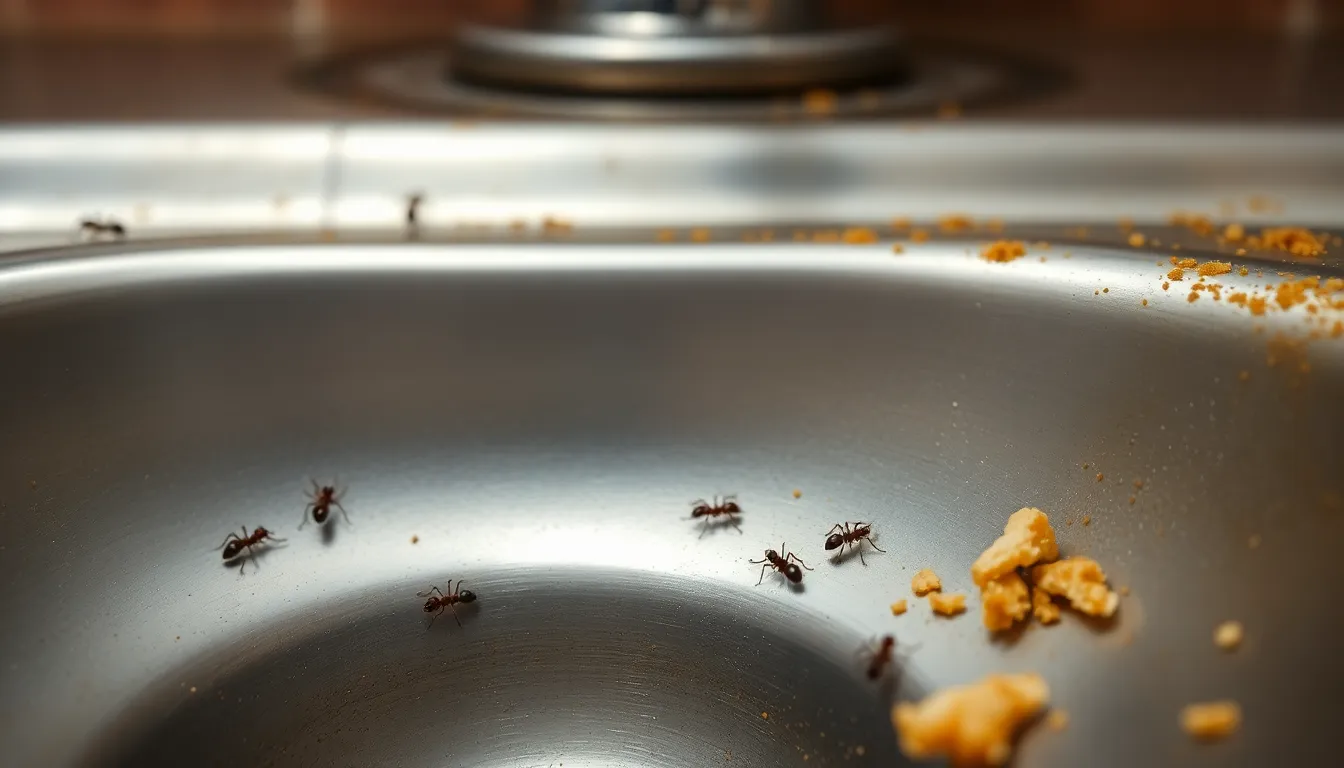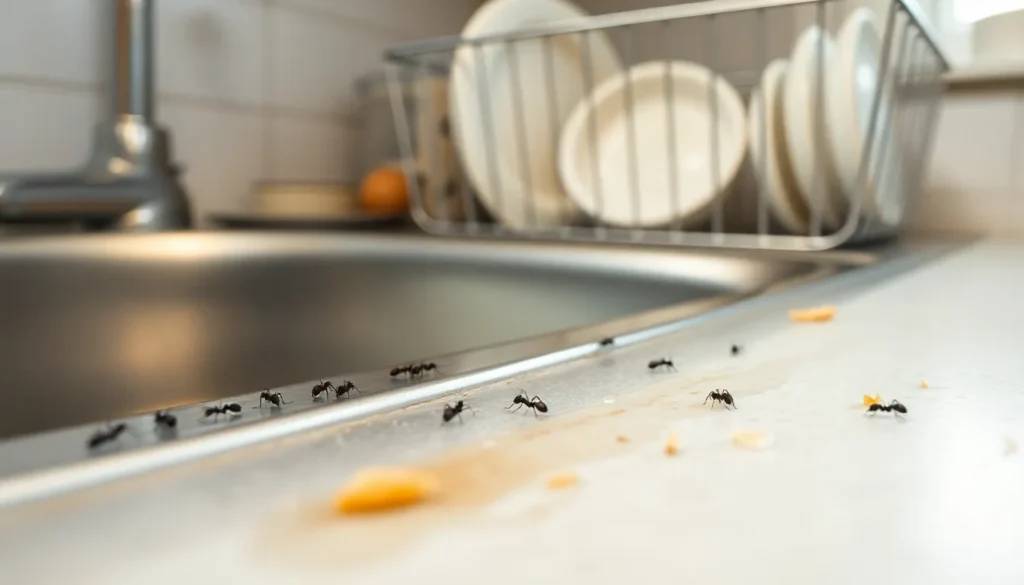Picture this: you’re enjoying a quiet moment in your kitchen when suddenly, a parade of very tiny ants marches right past your sink. They’re not just any ants; they’re the pint-sized invaders that seem to have a knack for turning your kitchen into their personal buffet. It’s like they’ve plotted a takeover, and your leftovers are the main course!
Table of Contents
ToggleOverview of Very Tiny Ants Around Kitchen Sink
Very tiny ants often appear around kitchen sinks, drawn by the availability of food and moisture. Common species include odorous house ants and pharaoh ants. These ants can enter homes through small cracks or gaps, quickly sensing sugary residues or food spills.
Ant colonies can number in the thousands, enabling them to invade kitchens in large groups. While most species aren’t harmful to humans, their presence indicates potential hygiene issues. Tiny ants often form visible trails leading to their food sources. Observing these trails can help identify and eliminate the source of the infestation.
Control methods focus on cleanliness and eliminating attractants. Wiping down counters, sealing food containers, and regularly taking out the trash help deter these pests. Some prefer using baits specifically designed to target tiny ants, while others opt for natural repellents like vinegar or essential oils.
Monitoring for any signs of ant activity around the kitchen sink aids in identifying specific species and implementing appropriate control methods. Proper identification allows homeowners to customize their approach and improve effectiveness. Staying aware of potential entry points allows better prevention strategies, ensuring kitchens remain ant-free.
Common Species of Tiny Ants

Tiny ants frequently invade kitchens, especially around sinks. Identifying and understanding these ants helps in controlling their presence effectively.
Identification Characteristics
Odorous house ants, characterized by their small size and dark brown to black coloration, emit a distinct odor when crushed. Pharaoh ants, slightly lighter in color, are also small but possess a yellow to light brown hue. Thief ants, another common type, are similar in size but have a more slender body structure. Each species shows unique traits, including antennae shape and body reflexivity. Observing these features aids in accurate identification, allowing for targeted control measures.
Behavior Patterns
Odorous house ants thrive in moist environments, often foraging near food sources. Pharaoh ants exhibit similar habits but prefer sweet food items and often form large colonies. Thief ants, known for their nocturnal feeding, tend to scavenge for protein-based foods. Nesting habits vary; odorous house ants nest indoors, while pharaoh ants may establish colonies both inside and outside. Ant trails typically lead to food sources, indicating their proximity to the kitchen. Understanding these behaviors facilitates effective pest management strategies.
Causes of Infestation
Tiny ants around the kitchen sink commonly arise from specific conditions. Understanding these causes helps in tackling the issue effectively.
Food Sources
Sugary residues and food spills attract very tiny ants. Crumbs left on counters or floors serve as a reliable food source for these pests. Additionally, pet food left out can also entice ants to invade. High moisture content in food also draws them in. Keeping all food items sealed reduces access to potential attractants. Regular sweeping and cleaning of kitchen surfaces minimizes food availability, deterring these pests from returning.
Nesting Locations
Cracks and crevices in walls often serve as nesting locations for tiny ants. They frequently establish colonies within these hidden spaces near sinks, where moisture provides a suitable environment. Underneath sinks or behind appliances also offers protection and warmth. Hidden nests allow ants to thrive while remaining undetected. Identifying these locations becomes crucial for effective control measures. Sealing entry points reduces the chance of an infestation taking hold, making kitchens less inviting to intruders.
Prevention Methods
Keeping tiny ants out of kitchens involves proactive steps focused on cleanliness and sealing potential entry points.
Cleaning Techniques
Eliminating food sources requires regular cleaning of kitchen surfaces. Wipe down counters and tables daily to remove crumbs and spills. Vacuuming floors also helps capture hidden food particles. Daily dishwashing prevents residue buildup, discouraging ant activity. Store food in sealed containers to limit access to enticing odors and nutrients. Cleaning pet food bowls and regularly emptying trash can reduce attractants that invite infestations. Utilize vinegar or citrus-based cleaners for additional repelling properties.
Sealing Entry Points
Identifying access routes strengthens kitchen defenses against tiny ants. Inspect walls, windows, and doors for cracks and crevices that allow entry. Sealing gaps with caulk or weather stripping minimizes access points significantly. Use mesh screens on windows and vents to block entry while allowing ventilation. Regularly check plumbing areas for leaks, as moisture invites ant colonies. Adding door sweeps can prevent ants from slipping beneath entryways. Comprehensive inspections and sealing measures create an unwelcoming environment for pests.
Treatment Options
Effective treatment options exist for managing very tiny ants around kitchen sinks. Both natural and chemical solutions can help eliminate infestations and prevent future occurrences.
Natural Remedies
Using natural remedies provides an eco-friendly approach to tackling ant problems. Vinegar mixed with equal parts water effectively disrupts ant trails, making it an ideal cleaner for surfaces. Essential oils such as peppermint or tea tree oil release strong scents that repel ants. Sprinkling diatomaceous earth in areas where ants frequent can cause dehydration, ultimately dispatching them. A combination of these natural solutions can help maintain an ant-free kitchen without harmful chemicals.
Chemical Solutions
Employing chemical solutions often yields quick results in ant control. Ant baits containing boric acid attract ants, who then carry the poison back to their colonies. Insecticide sprays specifically designed for ants can target these pests effectively. Residual sprays create a barrier against future invasions, ensuring long-lasting protection. When using chemical solutions, always follow product instructions to ensure safe application and effectiveness.
Tiny ants around the kitchen sink can be more than just a nuisance. They often indicate underlying hygiene issues and attract attention to food sources that need addressing. By understanding their behavior and preferences, homeowners can implement effective prevention and control strategies.
Regular cleaning and sealing food containers are essential steps in keeping these pests at bay. Additionally, identifying and sealing entry points can significantly reduce the likelihood of an infestation.
Whether opting for natural remedies or chemical solutions, maintaining a proactive approach ensures kitchens remain inviting for people and not for tiny ants.





